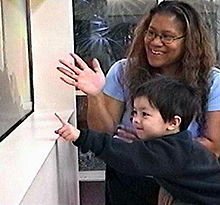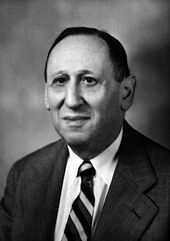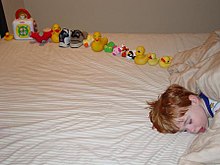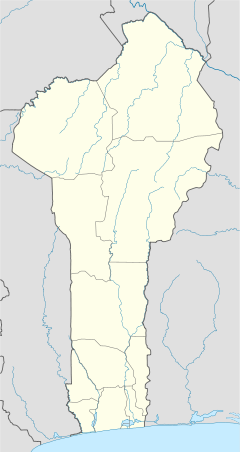전형적인 자폐증
Classic autism| 자폐증 | |
|---|---|
 | |
| 물건을 반복적으로 쌓거나 정렬하는 것은 일반적으로 자폐증과 관련이 있다. | |
| 전문 | 정신과, 소아과, 직업의학 |
| 증상 | 사회적 상호작용, 언어 및 비언어적 의사소통, 제한된 관심 및 반복적[1] 행동에 대한 문제 |
| 합병증 | 사회적 고립, 고용 문제, 스트레스 |
| 통상적인 개시 | 두세[2][3] 살까지 |
| 지속 | 평생[2] |
| 원인들 | 유전적 및 환경적[4] 요인 |
| 진단 방법 | 행동 및 발달[2] 이력에 기초함 |
| 차동 진단 | 반응성 애착 장애, 지적 장애, 정신[5] 분열증 |
| 치료 | 작업치료, 언어치료, 향정신성의약품[6][7] |
| 약 | 항정신병 약물, 항우울제, 각성제(관련 증상)[8] |
| 빈도수. | 2,480만 (2015년)[9] |
Kanner 자폐증, 즉 전형적인 자폐증은 현재 자폐 [3][10]스펙트럼 장애의 일부로 여겨지는 시대에 뒤떨어진 신경 발달 진단이다.'자율주의'라는 용어는 역사적으로 고전적인 [11]자폐증에 대해 특별히 언급하기 위해 사용되었지만,[12][13] 현재는 일반적으로 더 많이 사용되고 있다.
부모들은 아이가 태어난 [1][3]후 처음 3년 동안 자폐증의 징후를 종종 알아차렸다.
자폐증은 유전적 요인과 환경적 [4]요인의 조합에 의해 유발되며, 유전적 [14]요인들이 매우 우세하다고 생각되었다.다른 제안된 환경적 원인을 둘러싸고 논란이 일고 있다. 예를 들어, 백신 가설은 반증되었지만 특정 지역사회에서 계속 [15][16]영향력을 행사하고 있다.현대의 진단 매뉴얼에는 단 하나의 진단, 즉 자폐 스펙트럼 장애(ASD)가 포함되어 있으며, 여기에는 아스퍼거 증후군과 함께 전형적인 자폐증과 달리 명시되지 않은 만연한 발달 장애(PDD-NOS)[3]가 포함된다.
세계적으로, 2015년 현재[update],[9] 고전 자폐증은 2,480만 명의 사람들에게 영향을 미칠 것으로 추정된다.
특성.
고전적 자폐증은 유아기나 소아기에 증상이 처음 나타나는 매우 가변적인 신경[17] 발달 장애로, 일반적으로 [18]완화되지 않고 꾸준한 과정을 거친다.자폐증 환자들은 어떤 면에서는 심각한 손상을 입을 수 있지만 [19]다른 면에서는 평균적이거나 심지어 우월하다.노골적인 증상은 생후 6개월 이후부터 서서히 시작되어 2~3세 [20]무렵에 확립된다.일부 자폐아들은 정상적인 [21]속도로 발달 단계에 도달한 후 의사소통과 사회성이 퇴보하는 것을 경험한다.사회적 상호작용 장애, 의사소통 장애, 반복적 행동이라는 특징적인 3가지 증상으로 구분된다고 한다.비정형 식사와 같은 다른 측면도 흔하지만 [22]진단에 필수적인 것은 아니다.자폐증의 개별 증상은 일반 집단에서 발생하며 병적으로 심각한 특징과 [23]구별되는 뚜렷한 선이 없는 상태에서 높은 연관성을 갖지 못하는 것으로 보인다.
사회 발전
자폐증 환자들은 사회적 장애가 있고 많은 사람들이 당연하게 여기는 다른 사람들에 대한 직관력이 부족한 경우가 많다.특이한 사회 발달은 어린 시절부터 뚜렷하게 나타난다.자폐아들은 사회적 자극에 덜 관심을 보이고, 웃고 다른 사람들을 덜 쳐다보고, 자신의 이름에 덜 반응한다.자폐아들은 사회적 규범과 더 두드러지게 다르다; 예를 들어, 그들은 눈을 마주치고 방향을 바꾸는 것을 덜 가지고 있고, [24]사물을 가리키는 것과 같은 간단한 움직임을 자신을 표현하는 능력을 가지고 있지 않다.3세에서 5세 사이의 자폐아들은 사회적 이해를 보이고, 자발적으로 다른 사람들에게 다가가고, 감정을 모방하고 반응하고, 비언어적으로 소통하고, 다른 사람들과 교대로 소통할 가능성이 적다.그러나 그들은 그들의 주요 [25]간병인에 대한 애착을 형성한다.대부분의 자폐아들은 정신 발달이 높거나 자폐적 [26]특성이 덜 뚜렷한 아이들에서 이러한 차이가 사라지지만, 신경 전형적 아이들보다 애착 안정성이 다소 떨어졌다.고기능 자폐증을 가진 아이들은 자폐증 아이들이 혼자 있는 것을 선호한다는 일반적인 믿음에도 불구하고, 비자율적인 또래들에 비해 더 강렬하고 빈번한 외로움을 가지고 있다.친구를 사귀고 유지하는 것은 자폐증 사람들에게는 종종 어려운 것으로 판명된다.그들에게 있어, 친구의 수가 아니라 우정의 질이 그들이 얼마나 외로움을 느끼는지 예측한다.파티 초대를 초래하는 것과 같은 기능적 우정은 삶의 질에 더 [27]깊은 영향을 미칠 수 있습니다.
의사소통
생후 첫 해부터 의사소통의 차이가 있을 수 있으며, 옹알이의 시작 지연, 특이한 몸짓, 반응성 저하, 간병인과 동기화되지 않은 음성 패턴을 포함할 수 있다.2학년과 3학년 때 자폐아들은 옹알이, 자음, 단어, 단어 조합의 빈도가 낮고 다양성이 적다. 그들의 몸짓은 단어와 잘 통합되지 않는다.자폐아들은 요청을 하거나 경험을 공유할 가능성이 적고, 단순히 다른 사람의 말(에콜랄리아)[28]이나 [29]역대명사를 반복할 가능성이 더 높다.공동 주의력 결핍이 있을 수 있습니다. 예를 들어, 그들은 손이 [24]가리키는 물체 대신 가리키는 손을 볼 수 있습니다.자폐아들은 상상력이 풍부한 놀이와 기호들을 [28]언어로 발전시키는데 어려움을 겪을 수 있다.
반복 동작
자폐증 환자는 많은 형태의 반복적 또는 제한된 행동을 보일 수 있으며, 이는 RBS-R(Repeative Behavior Scale-Revisioned)에 의해 다음과 같이 분류된다.[30][better source needed]
- 틀에 박힌 행동: 손을 흔들거나 머리를 굴리거나 몸을 흔드는 것과 같은 반복적인 움직임.
- 강박적 행동:특정 순서로 물건을 배치하거나 물건을 확인하거나 손빨래를 하는 등 개인이 반복적으로 또는 엄격한 규칙에 따라 수행해야 한다고 느끼는 불안감을 줄이기 위한 시간이 많이 걸리는 행동입니다.
- 동일성:가구를 옮기지 말 것을 주장하거나 간섭을 거부하는 등 변화에 대한 저항.
- 의식적인 행동:변하지 않는 메뉴나 옷 입는 의식과 같은 일상 활동의 변하지 않는 패턴.
- 제한된 관심사:하나의 텔레비전 프로그램, 장난감 또는 게임에 대한 집착과 같이 주제나 집중 강도가 비정상적인 관심사 또는 고정관념.
어떤 반복적이거나 자해적인 행동도 자폐증에 특유한 것으로 보이지는 않지만 자폐증은 이러한 행동의 [31]발생 패턴과 심각도가 높아지는 것으로 보인다.
기타 증상
자폐증 환자는 [22]진단과 무관한 증상을 보일 수 있다.고전적인 자폐증을 가진 사람들의 약 0.5퍼센트에서 10퍼센트는 하찮은 것들을 암기하는 것과 같은 단편적인 기술에서부터 엄청난 자폐증 야만인들의 [32]매우 드문 재능에 이르기까지, 특이한 능력을 보여준다.감각 이상은 자폐증 환자의 90% 이상에서 발견되며,[22] 일부 사람들에 의해 핵심 특징으로 여겨지지만, 감각 증상이 자폐증과 다른 발달 [33]장애를 구별한다는 좋은 증거는 없었다.자폐증 환자의 약 60-80%가 근육 긴장 불량, 운동 계획 불량, 발가락 [22]걷기를 포함한 운동 징후를 가지고 있다.
원인들
처음에는 유전적, 인지적, 신경적 수준에서 전형적인 자폐증의 특징적인 3가지 [34]증상들에 대한 공통적인 원인이 있다고 추정되었다.하지만, 시간이 지나면서 자폐증은 종종 [34][35][36]동시에 발생하는 뚜렷한 원인을 가지고 있는 복잡하고 유전성이 높은 질환이라는 증거가 증가했습니다.
비록 이론 백신 부족 과학적인 증거들을 설득하는 것에 관한, 생물학적으로, 자폐형(ASD에 대해와 그에 따른 우려)과 잠재적인 백신 링크에 대한 사기 study,[38]부모의 우려에서 나오는 implausible,[37] 어린 시절 예방 접종, 이전에 관리 소아 질병의 발생률을 낮추기 위해 이끌어 왔다.솜에서 s여러 [39][40]어린이들의 예방 가능한 죽음들.
진단.
전형적인 자폐증의 진단은 원인이나 [23][41]메커니즘이 아닌 행동 증상에 근거했다.
분류
클래식 자폐증은 미국 정신의학회 진단 매뉴얼 제4판에 5가지 만연한 발달장애(PDD)[10] 중 하나로 자폐증으로 등재됐다.그러나 2013년 [10]PDD가 자폐 스펙트럼 장애의 단일 진단으로 무너졌고, 몇 년 [43]후 세계보건기구의 진단 매뉴얼 ICD-11(이전[42] 판에서 소아 자폐증으로 기재)이 그 뒤를 따랐다.전형적인 자폐증은 사회적 상호작용과 의사소통의 광범위한 이상, 심각하게 제한된 관심사,[18] 그리고 매우 반복적인 행동으로 특징지어진다.
PDD 중 아스퍼거 증후군은 징후와 가능한 원인에서 고전적 자폐증에 가장 가까웠다. 레트 증후군과 소아 분해 장애는 여러 징후를 공유하지만 잠재적으로 관련이 없는 것으로 이해되었다. 달리 명시되지 않은 PDD(PDD-NOS; 비정형 자폐증이라고도 함)는 기준 중 하나가 충족되지 않을 때 진단되었다.다른 4개의 PDD.[44] 사람들은 언어 [45]발달에 상당한 지연을 보이지 않는다면 보통 고전적인 자폐증보다는 아스퍼거 증후군의 진단을 끌어모으겠지만, 초기 언어 능력은 [46]성인기에 결과를 예측할 수 없는 것으로 밝혀졌다.
예후 및 관리

자폐증에 [6]대한 치료법은 알려져 있지 않으며, 고전 [48]자폐증에 대한 장기적인 예후를 다루는 연구는 거의 없다.많은 자폐아들은 사회적 지원, 미래의 취업 기회 또는 자기 [27]결정력이 부족하다.
자폐아를 치료할 때 주된 목표는 관련된 결손과 가족의 고통을 줄이고 삶의 질과 기능적 독립성을 높이는 것이다.일반적으로 IQ가 높을수록 치료에 대한 반응성이 높아지고 치료 [49]결과가 개선됩니다.서비스는 행동 분석가, 특수 교육 교사, 언어 병리학자와 자격증을 가진 심리학자에 의해 수행되어야 한다.
집중적이고 지속적인 특수 교육 프로그램과 생활 초기에 행동 치료는 종종 기능을 향상시키고 증상 심각도와 [50]부적응 행동을 감소시킨다. 3세 전후까지 개입이 중요하다는 주장은 [51]입증되지 않는다.
알려진 어떤 약도 자폐증의 사회적 및 의사소통 [medical citation needed]장애의 핵심 증상을 완화시키지 않는다.
교육
초기에, 집중적인 ABA 치료는 미취학 [52]아동의 의사소통과 적응 기능을 향상시키는데 효과가 있다는 것을 증명했다. 또한 그것은 그 연령층의 [50][52]지적 능력을 향상시키는데도 잘 확립되어 있다.아동 치료 프로그램이 자녀가 [50]성장한 후 상당한 개선으로 이어지는지는 알려지지 않았으며, 성인 주거 프로그램의 효과에 대한 제한적인 연구 결과도 [53]엇갈리고 있다.
대체의학
비록 많은 대체 치료법과 중재법이 사용되었지만, 과학적 [54]연구에 의해 뒷받침되는 것은 거의 없다.치료 접근법은 삶의 질 맥락에서 경험적 지원이 거의 없으며, 많은 프로그램은 예측 타당성과 실제 관련성이 [27]결여된 성공 측정에 초점을 맞추고 있다.일부 대체 치료법은 자폐증 환자들을 위험에 [55]빠뜨렸다.예를 들어, 2005년에 자폐증을 가진 5세 어린이가 실패한 [56][57][58]킬레이트 요법에 의해 사망했다.
역학
세계적으로, 2015년 현재[update],[9] 고전적 자폐증은 약 2,480만 명의 사람들에게 영향을 미치는 것으로 알려져 있다.그것이 뚜렷한 장애로 인식된 후, 자폐증 사례의 보고가 상당히 증가했는데, 이는 주로 진단 관행, 의뢰 패턴, 서비스의 가용성, 진단 나이, 그리고 대중의[59][60] 인식의 변화(특히 [61]여성들 사이)에 기인했다.
몇몇 다른 질환들이 자폐증을 가진 아이들에게서 흔히 목격되었다.다음과 같은 것이 있습니다.
- 지적 장애.지적 장애 기준을 충족한 자폐인의 비율은 25%에서 70%로 보고되었으며, 이는 자폐 [62]스펙트럼에 대한 개인의 지능을 평가하는 것이 어렵다는 것을 보여준다.이에 비해 PDD-NOS의 경우 지적장애와의 연관성이 훨씬 [63]약했으며, 정의에 따르면 아스퍼거가 제외된 [64]지적장애의 진단이 이루어졌다.
- 경미한 신체적 [65]이상은 자폐증 집단에서 유의하게 증가한다.
- 선점 진단.DSM-IV는 자폐증과 함께 많은 다른 질환의 동시 진단을 배제했지만, 주의력 결핍 과잉행동 장애(ADHD), 투레트 증후군, 그리고 이러한 질환들의 완전한 기준이 종종 존재했다.결과적으로, 최신 ASD는 이러한 [3]진단을 허용합니다.
역사

자폐증(영문 번역 자폐증)이라는 신조어는 1910년 스위스의 정신과 의사 유겐 블뢰러가 정신분열증 증세를 정의하면서 만든 말이다.He derived it from the Greek word autós (αὐτός, meaning "self"), and used it to mean morbid self-admiration, referring to "autistic withdrawal of the patient to his fantasies, against which any influence from outside becomes an intolerable disturbance".[67]자폐증이라는 단어는 1938년 비엔나 대학병원의 한스 아스퍼거가 아동심리학에 [68]대한 독일어 강의에서 Bleuler의 용어인 자폐성 사이코패스를 채택하면서 처음 현대적 의미를 갖게 되었다.아스퍼거 증후군은 여러 가지 이유로 1981년까지 [66]분리 진단으로 간주되지 않았지만, 현재는 둘 다 ASD의 일부로 간주되고 있다.존스 홉킨스 병원의 레오 카너는 1943년 보고서에서 [29]"조기 유아 자폐증"이라는 용어를 도입했을 때 영어로 자폐증을 처음으로 사용했다.이 주제에 관한 Kanner의 첫 번째 논문에서 묘사된 거의 모든 특징들, 특히 "자아적인 고독성"과 "일관성에 대한 불안감"은 여전히 자폐적 [35]장애의 전형으로 여겨진다.1960년대 후반부터 고전적 자폐증은 별도의 [69]증후군으로 확립되었다.
DSM-III가 자폐증과 소아 정신분열증을 구별하는 데는 1980년까지 걸렸다.1987년, DSM-III-R은 자폐증 진단을 위한 체크리스트를 제공했다.2013년 5월에 DSM-5가 출시되어 만연한 발달 장애의 분류가 업데이트되었다.PDD-NOS, 자폐증, 아스퍼거 증후군, 레트 증후군, CDD를 포함한 장애의 그룹은 제거되었고 자폐 스펙트럼 [70]장애의 일반적인 용어로 대체되었다.
레퍼런스
- ^ a b Landa RJ (March 2008). "Diagnosis of autism spectrum disorders in the first 3 years of life". Nature Clinical Practice. Neurology. 4 (3): 138–147. doi:10.1038/ncpneuro0731. PMID 18253102.
- ^ a b c "NIMH " Autism Spectrum Disorder". nimh.nih.gov. October 2016. Retrieved 20 April 2017.
- ^ a b c d e American Psychiatric Association (2013). "Autism Spectrum Disorder, 299.00 (F84.0)". Diagnostic and Statistical Manual of Mental Disorders, Fifth Edition (DSM-5). American Psychiatric Publishing. pp. 50–59.
- ^ a b Chaste P, Leboyer M (September 2012). "Autism risk factors: genes, environment, and gene-environment interactions". Dialogues in Clinical Neuroscience. 14 (3): 281–292. doi:10.31887/DCNS.2012.14.3/pchaste. PMC 3513682. PMID 23226953.
- ^ Corcoran J, Walsh J (9 February 2006). Clinical Assessment and Diagnosis in Social Work Practice. Oxford University Press, New York. p. 72. ISBN 978-0-19-516830-3. LCCN 2005027740. OCLC 466433183.
- ^ a b Myers SM, Johnson CP (November 2007). "Management of children with autism spectrum disorders". Pediatrics. 120 (5): 1162–1182. doi:10.1542/peds.2007-2362. PMID 17967921.
- ^ Sukhodolsky DG, Bloch MH, Panza KE, Reichow B (November 2013). "Cognitive-behavioral therapy for anxiety in children with high-functioning autism: a meta-analysis". Pediatrics. 132 (5): e1341–e1350. doi:10.1542/peds.2013-1193. PMC 3813396. PMID 24167175.
- ^ Ji N, Findling RL (March 2015). "An update on pharmacotherapy for autism spectrum disorder in children and adolescents". Current Opinion in Psychiatry. 28 (2): 91–101. doi:10.1097/YCO.0000000000000132. PMID 25602248. S2CID 206141453.
- ^ a b c Vos, Theo; et al. (GBD 2015 Disease and Injury Incidence and Prevalence Collaborators) (October 2016). "Global, regional, and national incidence, prevalence, and years lived with disability for 310 diseases and injuries, 1990-2015: a systematic analysis for the Global Burden of Disease Study 2015". Lancet. 388 (10053): 1545–1602. doi:10.1016/S0140-6736(16)31678-6. PMC 5055577. PMID 27733282.
- ^ a b c Rosen NE, Lord C, Volkmar FR (December 2021). "The Diagnosis of Autism: From Kanner to DSM-III to DSM-5 and Beyond". Journal of Autism and Developmental Disorders. 51 (12): 4253–4270. doi:10.1007/s10803-021-04904-1. PMC 8531066. PMID 33624215.
- ^ Rosen NE, Lord C, Volkmar FR (December 2021). "The Diagnosis of Autism: From Kanner to DSM-III to DSM-5 and Beyond". Journal of Autism and Developmental Disorders. 51 (12): 4253–4270. doi:10.1007/s10803-021-04904-1. PMC 8531066. PMID 33624215.
- ^ "Autism". National Institute for Health and Care Excellence. UK. Retrieved 2022-03-17.
- ^ Fletcher-Watson S (2019). Autism: a new introduction to psychological theory and current debates. Francesca Happé ([New edition; Updated edition] ed.). Abingdon, Oxon. ISBN 978-1-315-10169-9. OCLC 1073035060.
- ^ Tick B, Bolton P, Happé F, Rutter M, Rijsdijk F (May 2016). "Heritability of autism spectrum disorders: a meta-analysis of twin studies". Journal of Child Psychology and Psychiatry, and Allied Disciplines. 57 (5): 585–595. doi:10.1111/jcpp.12499. PMC 4996332. PMID 26709141.
- ^ Taylor LE, Swerdfeger AL, Eslick GD (June 2014). "Vaccines are not associated with autism: an evidence-based meta-analysis of case-control and cohort studies". Vaccine. 32 (29): 3623–3629. doi:10.1016/j.vaccine.2014.04.085. PMID 24814559.
- ^ Rutter M (January 2005). "Incidence of autism spectrum disorders: changes over time and their meaning". Acta Paediatrica. 94 (1): 2–15. doi:10.1111/j.1651-2227.2005.tb01779.x. PMID 15858952. S2CID 79259285.
- ^ Geschwind DH (October 2008). "Autism: many genes, common pathways?". Cell. 135 (3): 391–395. doi:10.1016/j.cell.2008.10.016. PMC 2756410. PMID 18984147.
- ^ a b "F84. Pervasive developmental disorders". ICD-10: International Statistical Classification of Diseases and Related Health Problems: Tenth Revision. World Health Organization. 2007. Archived from the original on 21 April 2013. Retrieved 10 October 2009.
- ^ Pinel JP (2011). Biopsychology (8th ed.). Boston, Massachusetts: Pearson. p. 235. ISBN 978-0-205-03099-6. OCLC 1085798897.
- ^ Rogers SJ (June 2009). "What are infant siblings teaching us about autism in infancy?". Autism Research. 2 (3): 125–137. doi:10.1002/aur.81. PMC 2791538. PMID 19582867.
- ^ Stefanatos GA (December 2008). "Regression in autistic spectrum disorders". Neuropsychology Review. 18 (4): 305–319. doi:10.1007/s11065-008-9073-y. PMID 18956241. S2CID 34658024.
- ^ a b c d Geschwind DH (2009). "Advances in autism". Annual Review of Medicine. 60: 367–380. doi:10.1146/annurev.med.60.053107.121225. PMC 3645857. PMID 19630577.
- ^ a b London E (October 2007). "The role of the neurobiologist in redefining the diagnosis of autism". Brain Pathology. 17 (4): 408–411. doi:10.1111/j.1750-3639.2007.00103.x. PMC 8095627. PMID 17919126. S2CID 24860348.
- ^ a b Volkmar FR, Paul R, Pelphrey KA, Rogers SJ, eds. (2014). Handbook of Autism and Pervasive Developmental Disorders: Volume Two: Assessment, Interventions, and Policy. Vol. 2 (4th ed.). Hoboken, New Jersey: John Wiley & Sons. p. 301. ISBN 978-1-118-28220-5. LCCN 2013034363. OCLC 946133861. Retrieved 1 March 2019.
- ^ Sigman M, Dijamco A, Gratier M, Rozga A (2004). "Early detection of core deficits in autism". Mental Retardation and Developmental Disabilities Research Reviews. 10 (4): 221–233. CiteSeerX 10.1.1.492.9930. doi:10.1002/mrdd.20046. PMID 15666338.
- ^ Rutgers AH, Bakermans-Kranenburg MJ, van Ijzendoorn MH, van Berckelaer-Onnes IA (September 2004). "Autism and attachment: a meta-analytic review". Journal of Child Psychology and Psychiatry, and Allied Disciplines. 45 (6): 1123–1134. doi:10.1111/j.1469-7610.2004.t01-1-00305.x. PMID 15257669.
- ^ a b c Burgess AF, Gutstein SE (May 2007). "Quality of Life for People with Autism: Raising the Standard for Evaluating Successful Outcomes" (PDF). Child and Adolescent Mental Health. 12 (2): 80–86. doi:10.1111/j.1475-3588.2006.00432.x. PMID 32811109. Archived from the original (PDF) on 3 December 2013. Retrieved 24 November 2013.
- ^ a b Landa R (2007). "Early communication development and intervention for children with autism". Mental Retardation and Developmental Disabilities Research Reviews. 13 (1): 16–25. doi:10.1002/mrdd.20134. PMID 17326115.
- ^ a b Kanner L (1943). "Autistic disturbances of affective contact". Acta Paedopsychiatrica. 35 (4): 100–136. PMID 4880460. 재인쇄된 위치
- ^ Lam KS, Aman MG (May 2007). "The Repetitive Behavior Scale-Revised: independent validation in individuals with autism spectrum disorders". Journal of Autism and Developmental Disorders. 37 (5): 855–866. doi:10.1007/s10803-006-0213-z. PMID 17048092. S2CID 41034513.
- ^ Bodfish JW, Symons FJ, Parker DE, Lewis MH (June 2000). "Varieties of repetitive behavior in autism: comparisons to mental retardation". Journal of Autism and Developmental Disorders. 30 (3): 237–243. doi:10.1023/A:1005596502855. PMID 11055459. S2CID 16706630.
- ^ Treffert DA (May 2009). "The savant syndrome: an extraordinary condition. A synopsis: past, present, future". Philosophical Transactions of the Royal Society of London. Series B, Biological Sciences. 364 (1522): 1351–1357. doi:10.1098/rstb.2008.0326. PMC 2677584. PMID 19528017.
- ^ Rogers SJ, Ozonoff S (December 2005). "Annotation: what do we know about sensory dysfunction in autism? A critical review of the empirical evidence". Journal of Child Psychology and Psychiatry, and Allied Disciplines. 46 (12): 1255–1268. doi:10.1111/j.1469-7610.2005.01431.x. PMID 16313426.
- ^ a b Happé F, Ronald A (December 2008). "The 'fractionable autism triad': a review of evidence from behavioural, genetic, cognitive and neural research". Neuropsychology Review. 18 (4): 287–304. doi:10.1007/s11065-008-9076-8. PMID 18956240. S2CID 13928876.
- ^ a b Happé F, Ronald A, Plomin R (October 2006). "Time to give up on a single explanation for autism". Nature Neuroscience. 9 (10): 1218–1220. doi:10.1038/nn1770. PMID 17001340.
- ^ a b Beaudet AL (May 2007). "Autism: highly heritable but not inherited". Nature Medicine. 13 (5): 534–536. doi:10.1038/nm0507-534. PMID 17479094. S2CID 11673879.
- ^ Gerber JS, Offit PA (February 2009). "Vaccines and autism: a tale of shifting hypotheses". Clinical Infectious Diseases. 48 (4): 456–461. doi:10.1086/596476. PMC 2908388. PMID 19128068.
- ^ Godlee F, Smith J, Marcovitch H (January 2011). "Wakefield's article linking MMR vaccine and autism was fraudulent". BMJ. 342: c7452. doi:10.1136/bmj.c7452. PMID 21209060. S2CID 43640126. Archived from the original on 11 November 2013.
- ^ 백신과 자폐증:
- Doja A, Roberts W (November 2006). "Immunizations and autism: a review of the literature". The Canadian Journal of Neurological Sciences. Le Journal Canadien des Sciences Neurologiques. 33 (4): 341–346. doi:10.1017/s031716710000528x. PMID 17168158.
- Gerber JS, Offit PA (February 2009). "Vaccines and autism: a tale of shifting hypotheses". Clinical Infectious Diseases. 48 (4): 456–461. doi:10.1086/596476. PMC 2908388. PMID 19128068.
- Gross L (May 2009). "A broken trust: lessons from the vaccine--autism wars". PLOS Biology. 7 (5): e1000114. doi:10.1371/journal.pbio.1000114. PMC 2682483. PMID 19478850.
- Paul R (June 2009). "Parents ask: Am I risking autism if I vaccinate my children?". Journal of Autism and Developmental Disorders. 39 (6): 962–963. doi:10.1007/s10803-009-0739-y. PMID 19363650. S2CID 34467853.
- Poland GA, Jacobson RM (January 2011). "The age-old struggle against the antivaccinationists". The New England Journal of Medicine. 364 (2): 97–99. doi:10.1056/NEJMp1010594. PMID 21226573.
- ^ McBrien J, Murphy J, Gill D, Cronin M, O'Donovan C, Cafferkey MT (July 2003). "Measles outbreak in Dublin, 2000". The Pediatric Infectious Disease Journal. 22 (7): 580–584. doi:10.1097/00006454-200307000-00002. PMID 12867830.
- ^ Baird G, Cass H, Slonims V (August 2003). "Diagnosis of autism". BMJ. 327 (7413): 488–493. doi:10.1136/bmj.327.7413.488. PMC 188387. PMID 12946972.
- ^ "ICD-10 Version:2016". icd.who.int. Retrieved 2022-04-28.
- ^ "World Health Organisation updates classification of autism in the ICD-11 – Autism Europe". Retrieved 2022-04-28.
- ^ Volkmar FR, State M, Klin A (January 2009). "Autism and autism spectrum disorders: diagnostic issues for the coming decade". Journal of Child Psychology and Psychiatry, and Allied Disciplines. 50 (1–2): 108–115. doi:10.1111/j.1469-7610.2008.02010.x. PMID 19220594.
- ^ "Diagnostic criteria for 299.00 Autistic Disorder". Diagnostic and statistical manual of mental disorders: DSM-IV (4th ed.). Washington, D.C.: American Psychiatric Association. 2000. ISBN 978-0-89042-025-6. LCCN 00024852. OCLC 768475353. Archived from the original on 29 October 2013 – via Centers for Disease Control.
- ^ Howlin P (2003-02-01). "Outcome in High-Functioning Adults with Autism with and Without Early Language Delays: Implications for the Differentiation Between Autism and Asperger Syndrome". Journal of Autism and Developmental Disorders. 33 (1): 3–13. doi:10.1023/A:1022270118899. ISSN 1573-3432. PMID 12708575. S2CID 35817450.
- ^ Powell K (August 2004). "Opening a window to the autistic brain". PLOS Biology. 2 (8): E267. doi:10.1371/journal.pbio.0020267. PMC 509312. PMID 15314667.
- ^ Seltzer MM, Shattuck P, Abbeduto L, Greenberg JS (2004). "Trajectory of development in adolescents and adults with autism". Mental Retardation and Developmental Disabilities Research Reviews. 10 (4): 234–247. doi:10.1002/mrdd.20038. PMID 15666341.
- ^ Eldevik S, Hastings RP, Hughes JC, Jahr E, Eikeseth S, Cross S (May 2009). "Meta-analysis of Early Intensive Behavioral Intervention for children with autism". Journal of Clinical Child and Adolescent Psychology. 38 (3): 439–450. CiteSeerX 10.1.1.607.9620. doi:10.1080/15374410902851739. PMID 19437303. S2CID 205873629.
- ^ a b c Rogers SJ, Vismara LA (January 2008). "Evidence-based comprehensive treatments for early autism". Journal of Clinical Child and Adolescent Psychology. 37 (1): 8–38. doi:10.1080/15374410701817808. PMC 2943764. PMID 18444052.
- ^ Howlin P, Magiati I, Charman T (January 2009). "Systematic review of early intensive behavioral interventions for children with autism". American Journal on Intellectual and Developmental Disabilities. 114 (1): 23–41. doi:10.1352/2009.114:23-41. PMID 19143460.
- ^ a b Eikeseth S (2009). "Outcome of comprehensive psycho-educational interventions for young children with autism". Research in Developmental Disabilities. 30 (1): 158–178. CiteSeerX 10.1.1.615.3336. doi:10.1016/j.ridd.2008.02.003. PMID 18385012.
- ^ Van Bourgondien ME, Reichle NC, Schopler E (April 2003). "Effects of a model treatment approach on adults with autism". Journal of Autism and Developmental Disorders. 33 (2): 131–140. doi:10.1023/A:1022931224934. PMID 12757352. S2CID 30125359.
- ^ Sigman M, Spence SJ, Wang AT (2006). "Autism from developmental and neuropsychological perspectives". Annual Review of Clinical Psychology. 2: 327–355. doi:10.1146/annurev.clinpsy.2.022305.095210. PMID 17716073.
- ^ Tye C, Runicles AK, Whitehouse AJ, Alvares GA (2019). "Characterizing the Interplay Between Autism Spectrum Disorder and Comorbid Medical Conditions: An Integrative Review". Frontiers in Psychiatry (Review). 9: 751. doi:10.3389/fpsyt.2018.00751. PMC 6354568. PMID 30733689.
- ^ Levy SE, Hyman SL (October 2008). "Complementary and alternative medicine treatments for children with autism spectrum disorders". Child and Adolescent Psychiatric Clinics of North America (Review). 17 (4): 803–20, ix. doi:10.1016/j.chc.2008.06.004. PMC 2597185. PMID 18775371.
- ^ Brown MJ, Willis T, Omalu B, Leiker R (August 2006). "Deaths resulting from hypocalcemia after administration of edetate disodium: 2003-2005". Pediatrics. 118 (2): e534–e536. doi:10.1542/peds.2006-0858. PMID 16882789. S2CID 28656831. Archived from the original on 27 July 2009.
- ^ James S, Stevenson SW, Silove N, Williams K (May 2015). James S (ed.). "Chelation for autism spectrum disorder (ASD)". The Cochrane Database of Systematic Reviews (Review) (5): CD010766. doi:10.1002/14651858.CD010766. PMID 26106752.
- ^ Fombonne E (June 2009). "Epidemiology of pervasive developmental disorders". Pediatric Research. 65 (6): 591–598. doi:10.1203/PDR.0b013e31819e7203. PMID 19218885.
- ^ Gernsbacher MA, Dawson M, Goldsmith HH (April 2005). "Three Reasons Not to Believe in an Autism Epidemic". Current Directions in Psychological Science. 14 (2): 55–58. doi:10.1111/j.0963-7214.2005.00334.x. PMC 4232964. PMID 25404790.
- ^ Russell G, Stapley S, Newlove-Delgado T, Salmon A, White R, Warren F, et al. (August 2021). "Time trends in autism diagnosis over 20 years: a UK population-based cohort study". Journal of Child Psychology and Psychiatry, and Allied Disciplines. 63 (6): 674–682. doi:10.1111/jcpp.13505. PMID 34414570. S2CID 237242123.
The figure starkly illustrates an overall 787% increase in recorded incidence of autism diagnosis over 20 years.
- ^ Dawson M, Mottron L, Gernsbacher MA (2008). "Learning in autism" (PDF). In Byrne JH, Roediger HL (eds.). Learning and Memory: A Comprehensive Reference. Vol. 2. Elsevier. pp. 759–772. doi:10.1016/B978-012370509-9.00152-2. ISBN 978-0-12-370504-4. OCLC 775005136. Archived from the original (PDF) on 3 March 2012. Retrieved 26 July 2008.
- ^ Chakrabarti S, Fombonne E (June 2001). "Pervasive developmental disorders in preschool children". JAMA. 285 (24): 3093–3099. doi:10.1001/jama.285.24.3093. PMID 11427137.
- ^ Diagnostic and Statistical Manual of Mental Disorders, Fourth Edition, Text Revision (DSM-IV-TR). Washington, D.C.: American Psychiatric Association. 2000. p. 80.
- ^ Ozgen HM, Hop JW, Hox JJ, Beemer FA, van Engeland H (March 2010). "Minor physical anomalies in autism: a meta-analysis". Molecular Psychiatry. 15 (3): 300–307. doi:10.1038/mp.2008.75. PMID 18626481.
- ^ a b Wolff S (August 2004). "The history of autism". European Child & Adolescent Psychiatry. 13 (4): 201–208. doi:10.1007/s00787-004-0363-5. PMID 15365889. S2CID 6106042.
- ^ Kuhn R (September 2004). "Eugen Bleuler's concepts of psychopathology". History of Psychiatry. 15 (59 Pt 3): 361–366. doi:10.1177/0957154X04044603. PMID 15386868. S2CID 5317716. 그 인용문은 Bleuler의 1910년 원본을 번역한 것이다.
- ^ Asperger H (1938). "Das psychisch abnormale Kind" [The psychically abnormal child]. Wien Klin Wochenschr (in German). 51: 1314–1317.
- ^ Fombonne E (September 2003). "Modern views of autism". Canadian Journal of Psychiatry. 48 (8): 503–505. doi:10.1177/070674370304800801. PMID 14574825. S2CID 8868418.
- ^ Baker JP (September 2013). "Autism at 70--redrawing the boundaries" (PDF). The New England Journal of Medicine. 369 (12): 1089–1091. doi:10.1056/NEJMp1306380. PMID 24047057. S2CID 44613078. Archived from the original (PDF) on 3 March 2019.
외부 링크
| 라이브러리 리소스 정보 전형적인 자폐증 |






